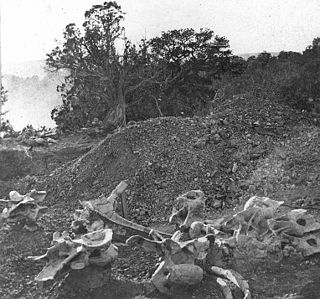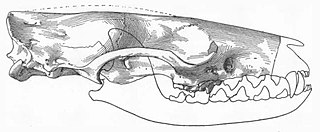Related Research Articles
Panthera is a genus within the family Felidae, and one of two extant genera in the subfamily Pantherinae. It contains the largest living members of the cat family. There are five living species: the jaguar, leopard, lion, snow leopard and tiger, as well as a number of extinct species, including the cave lion and American lion.

Garrett County is the westernmost county of the U.S. state of Maryland completely within the Appalachian Mountains. As of the 2020 census, the population was 28,806, making it the third-least populous county in Maryland. Its county seat is Oakland. The county was named for John Work Garrett (1820–1884), president of the Baltimore and Ohio Railroad. Created from Allegany County in 1872, it was the last county to be formed in the state. The county is part of the Western Maryland region of the state. Garrett County is bordered by four West Virginia counties and to the north the Maryland–Pennsylvania boundary known as the Mason–Dixon line. The eastern border with Allegany County was defined by the Bauer Report, submitted to Governor Lloyd Lowndes, Jr. on November 9, 1898. The Potomac River and State of West Virginia lie to the south and west.

Chicora is a borough in Butler County, Pennsylvania, United States. The population was 1,043 at the 2010 census.

Brokenstraw Township is a township in Warren County, Pennsylvania, United States. It was formed in 1800. The population was 1,726 at the 2020 census, down from 1,884 at the 2010 census.

Lewisburg is a city in and the county seat of Greenbrier County, West Virginia, United States. The population was 3,930 at the 2020 census.

Princeton is a city in and the county seat of Mercer County, West Virginia, United States. The population was 5,872 at the 2020 census. It is part of the Bluefield micropolitan area. The city hosts the Princeton WhistlePigs baseball club of the Appalachian League.

The Cave of the Winds was a natural cave behind Bridal Veil Falls at the Niagara Falls. The cave was some 130 feet (40 m) high, 100 feet (30 m) wide and 30 feet (9 m) in depth. It was discovered in 1834, and originally dubbed Aeolus's Cave, after the Greek god of winds.

Smoke Hole Caverns (SHC) is a picturesque show cave in Grant County in West Virginia's Eastern Panhandle.

The South River is one of the two main tributaries of the South Fork of the Shenandoah River. It begins south of Waynesboro, Virginia, and flows northward to Port Republic, where it merges with the North River to form the South Fork. The river is 52.6 miles (84.7 km) long.

The Shenandoah Valley Railroad is a shortline railroad operating 20.2 miles (32.5 km) of track between Staunton and Pleasant Valley, Virginia. The railroad interchanges with CSX and Buckingham Branch in Staunton and Norfolk Southern in Pleasant Valley. The railroad was purchased from Norfolk Southern in 1993 and is currently operated by the Durbin and Greenbrier Valley Railroad.
The West Virginia Railroad Museum is a railroad museum development located at 2 Railroad Avenue, WV 26241. The museum opened in 2014.

Garden Park is a paleontological site in Fremont County, Colorado, known for its Jurassic dinosaurs and the role the specimens played in the infamous Bone Wars of the late 19th century. Located 10 km (6.2 mi) north of Cañon City, the name originates from the area providing vegetables to the miners at nearby Cripple Creek in the 19th century. Garden Park proper is a triangular valley surrounded by cliffs on the southeast and southwest and by mountains to the north; however, the name is also refers to the dinosaur sites on top and along the cliffs. The dinosaur sites now form the Garden Park Paleontological Resource Area, which is overseen by the Bureau of Land Management.

The Sinks of Gandy — also called the Sinks of Gandy Creek, or simply "The Sinks" — are a modestly celebrated cave and underground stream at Osceola in eastern Randolph County, West Virginia, United States. The Sinks are on private property within the Monongahela National Forest.
Burnet Cave is an important archaeological and paleontological site located in Eddy County, New Mexico, United States within the Guadalupe Mountains about 26 miles west of Carlsbad.

Miocyon is an extinct genus of placental mammals from clade Carnivoraformes, that lived in North America from the early to late Eocene.

Bellefield Boiler Plant, also known as "The Cloud Factory" from its nickname's use in Michael Chabon's 1988 debut novel The Mysteries of Pittsburgh, is a boiler plant located in Junction Hollow between the Carnegie Institute of Pittsburgh and Carnegie Mellon University in the Oakland district of Pittsburgh, Pennsylvania.

The Ash Hollow Formation of the Ogallala Group is a geological formation found in Nebraska and South Dakota. It preserves fossils dating back to the Neogene period. It was named after Ash Hollow, Nebraska and can be seen in Ash Hollow State Historical Park. Ashfall Fossil Beds State Historical Park is within this formation.
Sully is an unincorporated community in Randolph County, in the U.S. state of West Virginia.

Viverravus is an extinct genus of placental mammals from extinct subfamily Viverravinae within extinct family Viverravidae, that lived in North America, Europe and Asia from the middle Paleocene to middle Eocene.
References
- ↑ "The Clark's Cave bone deposit and the late Pleistocene paleoecology of the central Appalachian Mountains of Virginia". Bulletin of Carnegie Museum of Natural History. 2. Carnegie Museum of Natural History: 14. January 19, 1977. Retrieved October 2, 2022.
38°06′N79°42′W / 38.1°N 79.7°W